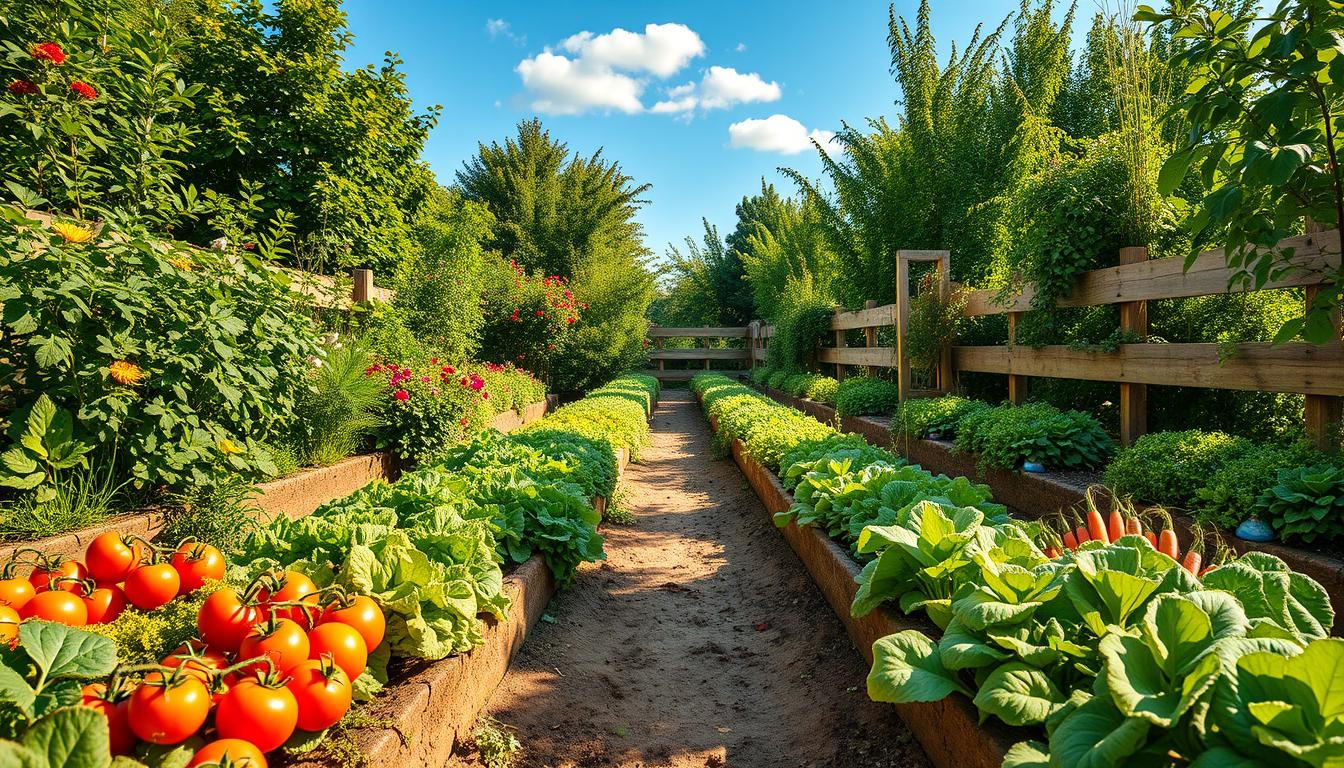I’m excited to share the basics of vegetable gardening with you. It’s a great way to start your gardening journey. With the right tips, you can enjoy fresh, healthy produce from your backyard.
Vegetable gardening helps reduce your carbon footprint. It’s a sustainable way to live.
Whether you have a small backyard or a large garden, I’ve got you covered. I’ll share tips and techniques for success in vegetable gardening. From choosing the right location to harvesting your bounty, I’ll guide you every step of the way.
Why I Love Vegetable Gardening
I’ve always been passionate about organic gardening and growing vegetables. It’s special to watch a seedling grow into a thriving plant. Then, I get to enjoy the freshest, healthiest produce.
By growing my own food, I avoid pesticides and harmful chemicals. This is good for my health and the environment.
Personal Benefits of Growing My Own Food
One of the best things is eating something I’ve grown myself. It saves money on grocery bills. I can also share my harvest with family and friends.
Some benefits of growing my own vegetables include:
- Fresh, healthy produce right in my own backyard
- Cost savings on grocery bills
- A sense of pride and accomplishment
- Opportunities to share my harvest with others
Connection to Nature and Sustainability
Organic gardening and growing vegetables connect me to nature. They help me reduce my reliance on industrial agriculture. By using natural methods, I create a balanced ecosystem in my garden. 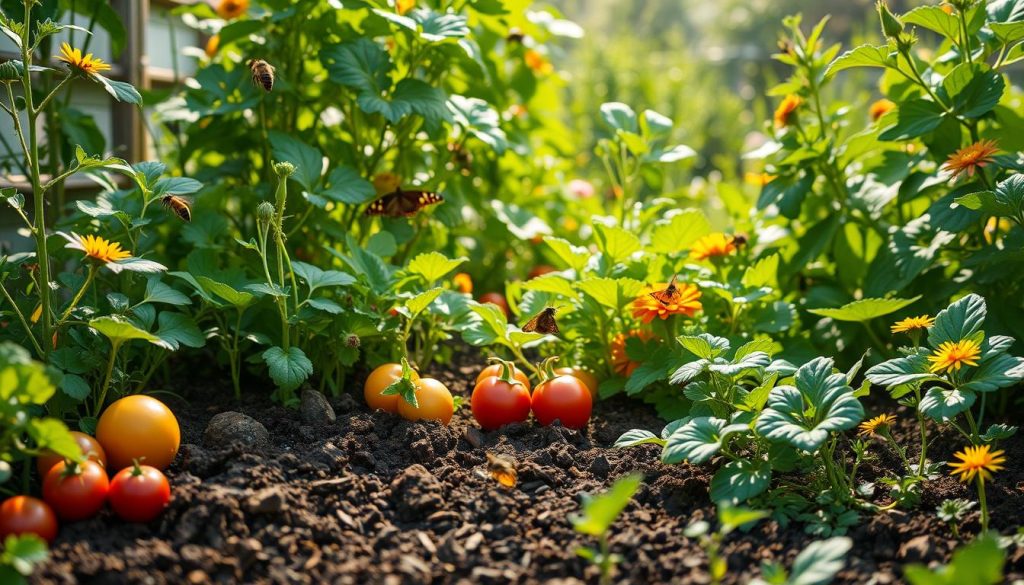
Getting Started with Vegetable Gardening
To start growing your own vegetables, pick the right spot in your yard. Look for a place that gets at least six hours of direct sunlight a day. It should also have soil that drains well. This ensures your garden is perfect for the plants you want to grow.
When picking a spot, think about how big each plant will get and what they need to grow. A good vegetable garden design considers the space each plant needs. Here are some important things to remember:
- Soil quality: Test your soil to find out its pH level and nutrient content.
- Sunlight: Make sure your garden gets enough direct sunlight each day.
- Water: Ensure your garden has a reliable water source.
By choosing the right spot and preparing your soil, you’re on your way to a thriving vegetable garden. Always research the needs of the vegetables you want to grow. Then, plan your garden design accordingly.
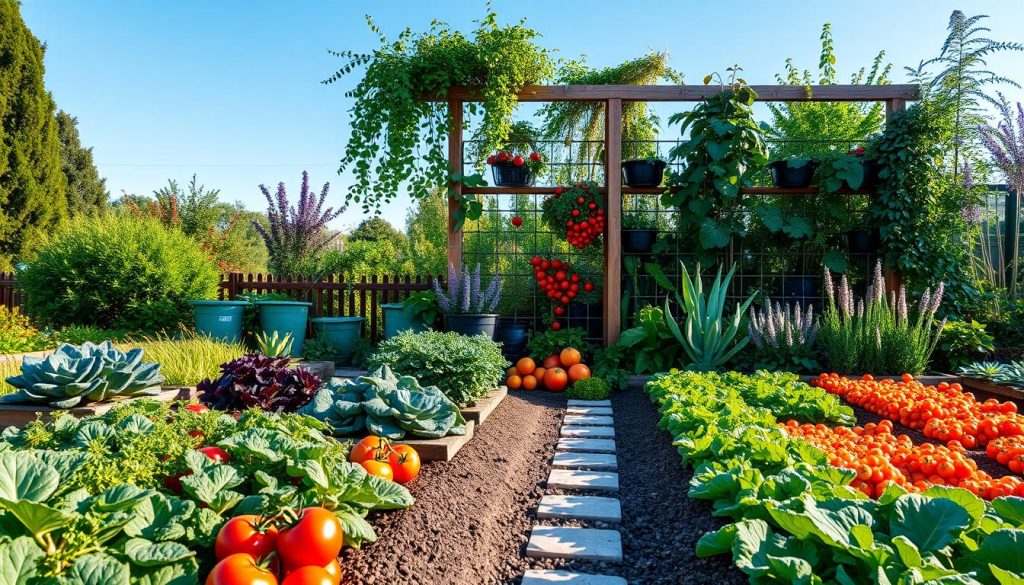
With some planning and preparation, you can make a beautiful and productive vegetable garden. It will give you fresh, delicious vegetables all season long.
Selecting the Right Vegetables for My Garden
I’m diving into vegetable gardening and excited to pick the right plants. There are so many choices, it’s hard to decide. I’ll choose easy-to-grow veggies perfect for beginners.
It’s key to think about my climate and season when picking veggies. Gardening tips say to pick what’s right for my area. For example, in cool weather, I might choose broccoli or carrots. In warmer weather, okra or peppers are better.
Popular Vegetables for New Gardeners
- Tomatoes: a classic choice for any garden, easy to grow and versatile in recipes
- Cucumbers: perfect for salads, sandwiches, and snacking, and can be grown on a trellis
- Zucchini: a low-maintenance option that’s great for grilling, sautéing, or baking
By picking the right veggies, I’ll have a great harvest and avoid failures. With these tips, I’m ready for a successful gardening journey.
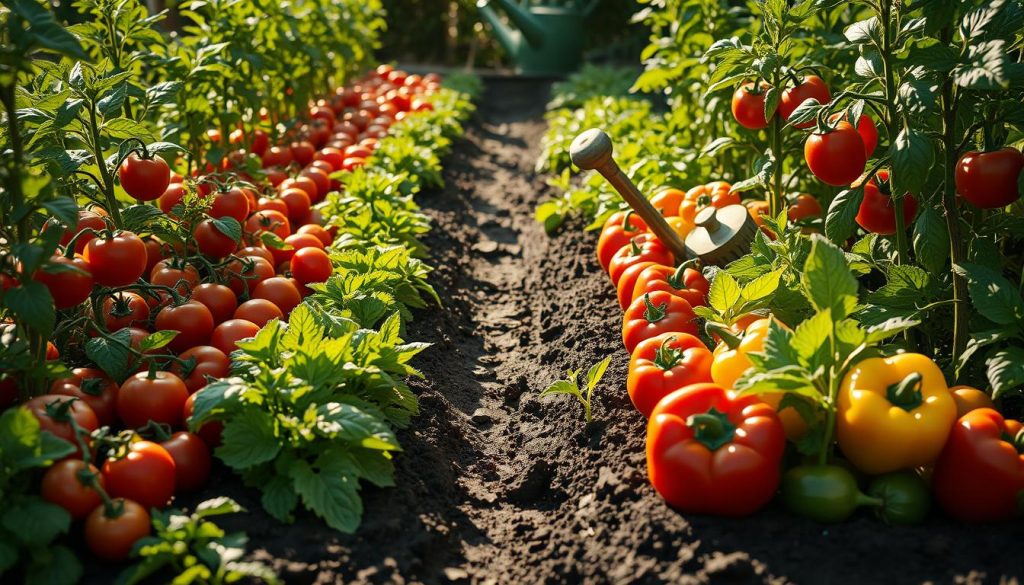
Essential Gardening Tools I Need
As I journey through gardening, I’ve learned the value of the right tools. They save me time and effort, making gardening more productive. Here, I’ll share my top gardening tips and essential tools for organic gardening.
Having the right tools is crucial for gardening. They help me complete tasks like planting seeds and harvesting crops efficiently. Here are some must-have tools for new gardeners:
Must-Have Tools for New Gardeners
- Garden fork
- Trowel
- Watering can
Recommended Brands and Features
I look for brands that focus on organic gardening when choosing tools. My favorites are Fiskars, Corona, and Haws. These brands offer tools made from durable materials like stainless steel and copper.
Investing in the right tools makes gardening more efficient. Whether I’m planting, watering, or harvesting, the right tools are key. With these tips and tools, my organic gardening will improve.
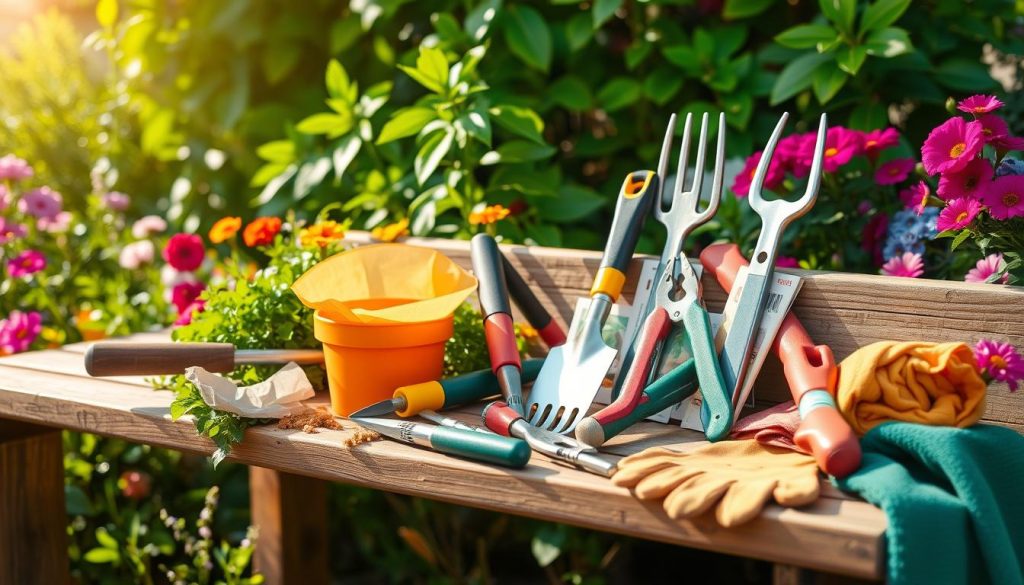
Planning My Vegetable Garden Layout
Creating a thriving vegetable garden starts with planning. A good layout is crucial for healthy plants. I think about each plant’s size and needs when designing my garden. This approach helps my garden benefit both me and the environment.
First, I focus on the basics of garden design. I choose the right spot, prepare the soil, and pick vegetables that fit my climate. Companion planting is also key. For instance, marigolds with tomatoes can fight nematodes, and basil can enhance tomato flavor.
- Rotate crops to keep the soil rich
- Use natural pest control, like beneficial insects
- Have a diverse garden with many plants and flowers
By following these tips, I can make a garden that’s both thriving and sustainable. It will bring me joy and fresh produce all season.
The Importance of Soil Health
As I grow vegetables, I’ve learned that soil health is key. In organic gardening, the soil is the base, giving plants the nutrients they need. To keep my soil healthy, I test its quality and add necessary amendments.
Testing Soil Quality
I can test my soil with a DIY kit or send a sample to a lab. This tells me about the soil’s pH and nutrients. I can then decide on the right amendments.
Amendments to Improve Soil
After testing, I might add compost, manure, or fertilizers to my soil. These improve the soil’s health and fertility. They help adjust the pH and nutrient levels, making it better for my vegetables.
By focusing on soil health and using the right amendments, I can have a thriving garden. This approach is good for my plants and the environment. It makes organic gardening a sustainable way to grow vegetables.
Watering Techniques for Success
Watering is key in vegetable gardening. The amount of water needed varies by climate, soil, and plant type. Most veggies need 1-2 inches of water weekly for growth.
To water right, I check the soil often. If it’s dry, it’s time to water. Signs of too little water include wilted leaves and dry soil. Too much water can cause root rot, so finding the balance is crucial.
How Often Should I Water My Plants?
Watering schedules vary by plant needs. Here are some tips:
- Check soil moisture by inserting a finger up to the knuckle.
- Water deeply but not too often to promote deep roots.
- Try not to get water on leaves to avoid fungal diseases.
Signs of Overwatering or Underwatering
Knowing signs of too much or too little water helps adjust watering. Look out for:
- Yellow leaves or droopy stems, signs of overwatering.
- Wilted leaves or dry soil, signs of underwatering.
Pest Control Strategies I Can Use
As I care for my garden, I’ve learned that pest control is key. It’s important for organic and sustainable gardening. I want to protect my crops without harming the environment.
I’ve found that using physical barriers works well. Row covers and fine mesh keep pests away from my plants. I also use organic pest control like neem oil, diatomaceous earth, or insecticidal soap.
Physical Barriers to Protect My Crops
Physical barriers are a simple yet effective way to prevent pests from damaging my crops. Some examples of physical barriers include:
- Row covers: lightweight, porous fabrics that allow water and light to reach my plants while keeping pests out
- Fine mesh: a tightly woven mesh that prevents small pests, like aphids and whiteflies, from reaching my plants
Organic Pest Control Measures
When physical barriers are not enough, I turn to organic pest control measures to manage pest populations. Some examples of organic pest control measures include:
- Neem oil: a natural insecticide that disrupts pest hormone systems, preventing them from reproducing
- Diatomaceous earth: a powder made from fossilized algae that dehydrates and kills pests
- Insecticidal soap: a mild dish soap that can be used to control soft-bodied pests like aphids and spider mites
Harvesting My Vegetables
Harvesting my vegetables is the most rewarding part of gardening. With the right tips, I get a lot of produce. I check the plant’s size, color, and texture to know when to pick. For instance, tomatoes are ready when they’re fully red and soft to the touch.
Timing is crucial in gardening. I use methods like cutting or twisting to pick my veggies without harm. This way, I get the best taste and texture. Here are some key tips for harvesting:
- Check the plant’s mature size and color to determine if it’s ready for harvest
- Use the right techniques to avoid damaging the plant or fruit
- Harvest at the right time to enjoy the best flavor and texture
By following these tips, I ensure a great harvest. With time and practice, I’ve grown more confident in gardening. I’m excited to keep learning and growing my own veggies.
Storing and Preserving My Homegrown Vegetables
After I harvest my vegetables, I want to enjoy them all year. To do this, I need to store and preserve them right. Gardening tips, especially for sustainable gardening, help a lot. They teach me how to keep my veggies fresh longer.
When storing veggies, keeping humidity and moisture down is key. I use containers or bags that let air in. This simple trick keeps my veggies in top shape.
Best Practices for Storing Fresh Vegetables
Here are some top tips for storing fresh veggies:
- Use breathable containers or bags to maintain humidity and prevent moisture buildup
- Keep vegetables away from direct sunlight and heat sources
- Store vegetables in a cool, dry place, such as a basement or pantry
Simple Ways to Preserve My Harvest
Preserving my harvest is key in sustainable gardening. I can use refrigeration, freezing, or canning. These methods let me enjoy my veggies all year and cut down on waste.
Troubleshooting Common Gardening Issues
As I care for my garden, I’ve learned to spot and fix common problems early. Organic gardening and good tips help me avoid issues. First, I check my plants for signs of stress, disease, or pests.
Soil quality, watering, and fertilization are key. I use natural soil amendments to keep nutrients balanced. I also watch my watering to avoid overdoing it, which can harm my plants.
I’ve faced issues like nutrient shortages, pests, and diseases. To solve these, I’ve found a few strategies:
- Using natural pest control, like beneficial insects or neem oil
- Rotating crops to keep the soil rich
- Adding compost to improve soil health
By using these tips and organic gardening, my garden is strong and healthy. Troubleshooting is a continuous process that needs patience and a love for learning.
| Common Gardening Issues | Solutions |
|---|---|
| Nutrient deficiencies | Use natural amendments, like compost or manure |
| Pests | Introduce beneficial insects or use neem oil |
| Diseases | Improve air circulation, remove infected plants, and use organic fungicides |
Celebrating My Gardening Success
As my vegetable gardening journey ends, I feel proud and accomplished. Sharing my harvest with family and friends has been a joy. Seeing their happiness with the fresh produce I grew has been rewarding.
Looking back, I’ve learned a lot about nature and soil health. I’ve also grown as a gardener. Overcoming challenges has made me appreciate growing my own food even more.
I’m excited to keep gardening, trying new things, and sharing my knowledge. The sense of accomplishment and connection to nature is priceless.

